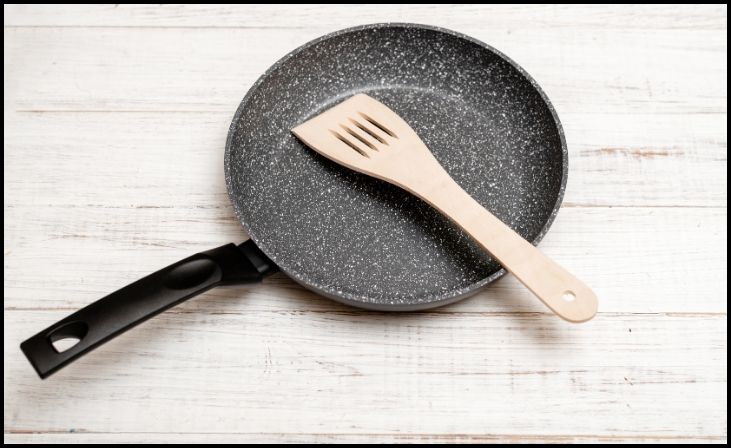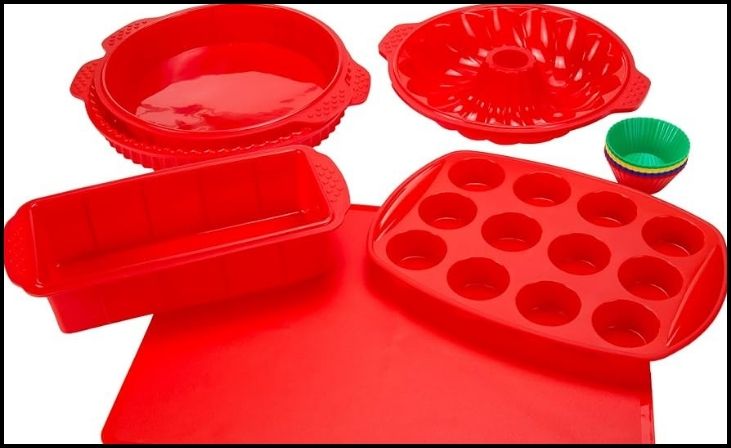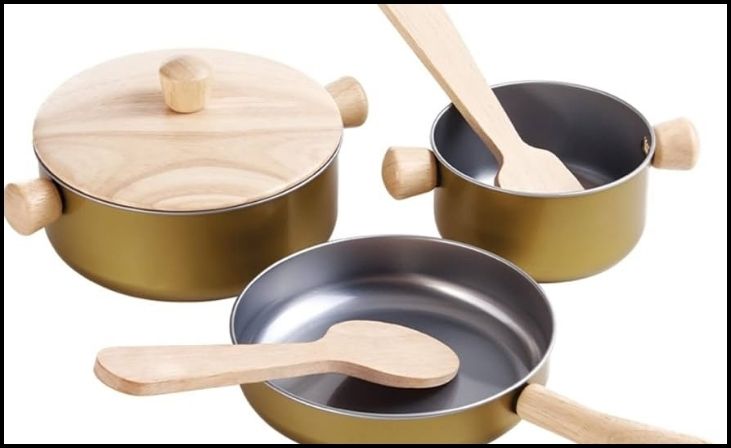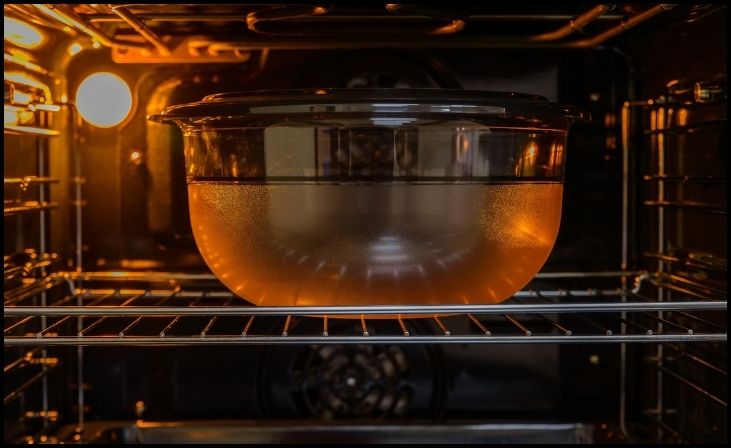How can you tell if your new stove-to-oven cookware is truly oven safe cookware?
Oven safe pans, pots, and skillets easily transfer from stovetop to oven, allowing cooks to use both without dirtying more cookware. This cookware doesn’t just save time; many pans have premium features that make them versatile.
Unfortunately, some cookware isn’t oven-safe. Furthermore, even oven-safe cookware has a temperature limit.
I’m here to help you find oven-safe cookware. Which cookware can withstand the heat?
How To Know Which Cookware Is Oven Safe?
A few signs can determine a pot or pan’s oven safety. First, always check the bottom of your cookware for an oven-safe mark. Next, pay attention to plastic cookware that could melt in the oven. You can also check the manufacturer’s oven temperature instructions.
There are numerous varieties of cookware that are “oven-safe,” but the phrase is most usually applied to those that may be used on the cooktop and in the oven simultaneously.
Oven-safe cookware can withstand high heat in the oven for a long time without melting or cracking.
Unsafe pans and pots can damage both the oven and the cookware.
The oven’s high temperature may also be a fire hazard. Because of this, you need oven-safe cookware.
- oven-safe marked – When choosing a pan, check the bottom for a safe mark. Many brands say this.
- Check cookware for oven-damaging plastic.
- Identify the pan’s material because each reacts differently to heat.
- Check for a nonstick surface like Teflon and ask the manufacturer about the ideal temperature.
Best Oven Safe Cookware
Lodge Cast Iron Skillet

- Brand – Lodge
- Material – Cast Iron
- Special Feature – Induction Stovetop Compatible
- Color – Black/Red Silicone
- Product Care Instructions – Dishwasher Safe
The set contains a 10.25-inch skillet and a red silicone handle holder.
A complete cookware set may not be necessary. Would a single oven-safe pan do? Consider this cast iron pan to save money.
The lodge is a 120-year-old US brand. High-quality, durable, versatile cast iron is their trademark. Every detail matters, including 100% vegetable oil for seasoning.
Lodge says this will be your go-to pan for centuries. This cast-iron skillet can last a lifetime.
Pros
- Oven, stove, grill, campfire, and induction cooktop compatible
- Hand wash/dry
- Handle-holder included
- One-pan oven-safe solution that’s inexpensive.
Cons
- Cast iron is harder
- No lid
- Not for those who need a set
WearEver Non-stick Ceramic Cookware Set
WearEver Non-stick Ceramic Cookware Set

- Material – Aluminum
- Color – Gold
- Brand – WearEver
- Size – 10 Piece
- Handle Material – Silicone
- Is Dishwasher Safe – Yes
This set has a temperature range of 400°C (750°F), making it highly durable. This fantastic nonstick product goes above and beyond the average user’s expectations.
Glass lids and silicone riveted handles are included in the package. 177°C (350°F) is the maximum temperature at which the glass lids are safe.
Cooking outcomes are said to be flawless, thanks to its outstanding performance. In addition, they say it’s stain and scratch-resistant. It is the one for you if you’re looking for a high-quality aluminum base.
It is a great cookware set for the price, plus it’s safe to use in the oven. However, it might be a better, longer-lasting option if you’re looking for a nonstick set that you can use in the oven often.
Pros
- Set can resist extremely high temperatures.
- Low-cost
- Non-PTFE (i.e. Teflon free)
- Dishwasher safe
- Ceramic with color choices
Cons
- Nonstick coating caused sticking and discoloration.
- Oven-safe lids to 177°C (350°F).
Lagostina Tri-Ply Stainless Steel Multiclad Cookware Set
Lagostina Tri-Ply Stainless Steel Multiclad Cookware Set

- Brand – Lagostina
- Handle Material – Stainless, Stainless Steel, Metal, Steel
- Number of Pieces – 12
- Item Volume – 2177.59 Fluid Ounces
This tri-ply pan is made of stainless steel and aluminum. 18/10 stainless steel is perfect for searing and keeping flavors pure. Aluminum aids heating.
It is Oven safe to 260°C (500°F).
Lids and handles are made of stainless steel and have riveted construction for a solid fit. Designed to last a lifetime, these handles are crafted with stability and strength in mind. Safe for dishwashers and ovens.
Pros
- Dishwasher-safe
- 260°C (500°F) oven safe.
- Stainless bottoms work on all cooktops.
Cons
- Non-flat bottoms
- Oven-safe lids to 177°C (350°F).
- Costly
Calphalon Contemporary Tri-Ply Stainless Steel Cooking Set
Calphalon Contemporary Tri-Ply Stainless Steel Cooking Set

- Material – Stainless Steel
- Color – Silver
- Brand – Calphalon
- Size – 10-Piece
- Handle Material – Stainless, Stainless Steel, Steel
- Is Dishwasher Safe – Yes
Stainless steel cookware may be obtained at any price point, but it is worth buying. We adore Calphalon Contemporary Tri-Ply Stainless Steel Cooking Set.
After numerous nonstick pans, we bought this. Because it’s stainless steel, we don’t have to worry about nonstick coatings chipping into our food.
After cooking, we can wash it in the dishwasher. These pans are oven and broiler safe and work on gas, electric, halogen, Glass, and induction stovetops.
Pros
- It’s lovely, pricey kitchenware.
- Tri-Ply base distributes heat evenly, so food cooks evenly.
- When handled properly, it can be almost nonstick.
Cons
- Thin, fragile handles provide no grip.
- Over time, stainless cookware stains.
- Riveted handles might be hard to clean.
T-Fal Ultimate Hard Anodized Cookware
T-Fal Ultimate Hard Anodized Cookware

- Material – Aluminum
- Color – Red
- Brand – T-fal
- Size – 12-Piece
- Handle Material – Anodized, Silicone, Metal
- Is Dishwasher Safe – Yes
This 14-piece set includes a Dutch oven and steamer insert with side handles.
Pieces can withstand 204°C (400°F), but lids only 177°C (350°F).
This titanium-cored set is a kitchen workhorse. It’s high-performance, durable nonstick oven cookware.
Nonstick coating is scratch- and corrosion-resistant and won’t react with acidic foods. In addition, the nonstick inside is durable. As a result, cooking and cleaning are easier.
Silicone grips & vented lids – Safe and comfortable handles. Visible vented tempered glass lids absorb heat and moisture.
Pros
- Robust
- Dishwasher safe
- User-friendly
- Good nonstick
Cons
- Induction-unsafe
- Teflon-based
- Discoloration scrapes reported over time
Which Cookware Materials are Oven Safe?
If you are looking for cookware that is safe to use in the oven and is also effective, the following items will be of great use to you:
Metals
Due to chemical reactions and poor heat conductivity, not all metals are suitable for use in an oven.
Metals like stainless steel and cast iron, which don’t alter food’s taste, are ideal for cooking inside the oven.
Aluminum is also an excellent metal due to its lightweight and high thermal conductivity. It’s also corrosion-resistant. It’s often mixed with other metals to boost its strength.
Cast Iron
Raw cast iron skillets, enameled cast iron pans, and Dutch ovens are reliable for stove-to-oven cooking. Cast iron is sturdy, effectively distributes heat, and can become nonstick if seasoned.
Stainless Steel
Stainless steel is a popular cookware material because it’s sturdy and resistant to high temperatures.
Carbon Steel
Carbon steel combines cast iron with stainless steel’s properties. Carbon steel, Similar to cast iron, but lighter. Carbon steel is best for stove-to-oven cooking and induction cooktops.
Ceramics

Only unglazed, non-adhesive ceramics can be used in the oven. Overall, make sure it oven-safe.
Oven Safe Glass

Special oven-safe Glass must be handled with care, as it should not be placed directly in an extremely hot oven or immediately placed in cold water after it has been removed from the oven. Glass may break.
Silicone

Silicone pans are safe in the oven and microwave. They withstand 450°F. Some come in animal shapes and sizes, making baking more fun.
Which Materials Are Not Oven Safe?
Now We all know which materials to use but which to avoid? For example, plastic handles or parts are not oven-safe.
Wood

Wood cookware warps easily. The wooden pan warps when bent.
No one wants twisted wooden kitchenware. If only the handles are wooden, don’t use wooden pans or pots in the oven.
Wrapping wooden handles won’t work since heat scorches and dry up the wood.
Plastics

Oven-safe plastics are rare. Therefore identifying it may not be easy.
Before using it in the oven, check with the manufacturer or buy oven-safe cookware.
A Dutch oven with plastic handles may not be safe, despite some plastic being heat-resistant. Replace oven-safe handles.
Pot Handles And Oven Safe Cookware
Cookware handles should be durable, pleasant, and safe. In addition, they should match the pot’s purpose.
Cookware handles include:
Silicone handles – Silicone is a good heat conductor; therefore, silicone handles are suitable for oven cookware, but oven mitts may be needed above 450˚F.
They look inferior and may not be people’s first pick.
Metal handles are great for cookware since they have limited heat conductivity and get hot slowly. They’re also attractive and durable.
Wooden handles are also unsuitable for the oven because they might crack and make the pot unsafe to hold.
Phenolic handles are made of plastic and can be used in the oven to some extent. High temperatures of around 500˚F may still harm them, but with care, they may survive.
Stoneware handles can withstand 350 F. Preheating stoneware handles might cause breakage before food is ready.
How To Make Oven Cookware Safe
Quality oven cookware is pricey. If you can afford oven-safe dishes, excellent! As you’ll see below, there are ways to make your present cookware oven-safe:
First, learn the pan or pot’s temperature limits, which the manufacturer may state on the bottom of the pan.
Sometimes a pan’s material is oven-safe, but the handles aren’t.
Skillet handles can only withstand 350 F, so they won’t be as helpful for cooking at higher temperatures. Instead, an expert suggests wrapping pan handles in wet paper towels and aluminum foil to make them oven-safe.
Safer silicone hand covers are another option. However, silicone heats slowly and can only withstand 450˚ in the oven.
Silicone hand covers work better on pots with bare metal handles when transferring the pot/pan into the oven, removing the cover, and then transferring hot food out of the oven, especially at high temperatures.
When you are removing the pan from the oven, the hand cover should be removed quickly since it absorbs heat quickly and requires oven mitts to handle.
Other Tips For Oven Safe Cookware
The pan and cover must be oven-safe. Pots and pans can have silicone or dishwasher-safe glass lids. Getting oven-safe cookware is your best bet for cooking success. Less confusion makes meal prep easier.
To make your cookware oven-safe, choose quality materials and avoid particular ones. Specifically:
Don’t put oven-safe cookware in a preheating oven.
Even if your cookware is oven-safe, don’t preheat it. During the preheating phase, most ovens send bursts of heat at temperatures significantly higher than the required temperature. Even high-quality oven-safe cookware like Pyrex can break.
Don’t use nonstick pans or skillets.
Anyone who’s struggled with a burned skillet or pot can appreciate nonstick cookware. However, nonstick cookware isn’t usually oven-safe. Nonstick pans can only handle 350 degrees F, so they’re easily ruined in the oven. Most nonstick pans leach chemicals into food when overheated.
Beware of cookware with “mixed materials.”
Some cookware has a plastic lid knob that can only withstand oven temperatures of 375 degrees F or less. It is a prime example of the dangers of oven-safe cookware with mixed materials.
Silicone padding on a pan’s handle may feel nice in the store, but it limits the pan’s oven temperature. Some silicone melts at 400°F. Why take a chance? Buy pans with metal handles for safety and durability.
Conclusion
Due to high oven temperatures, it’s crucial to know what cookware to use and what not to use to avoid destroying your cookware and chemical and fire concerns.
When buying cookware for the first time, ask if the pots and pans can also be used in the oven.
If oven safety was a priority, I’d choose the WearEver C944SA Pure Living Cookware Set. It’s cheap. You can also go for T-Fal E918SE Ultimate Cookware Set because it’s Convenient, sturdy, and user-friendly.
I’d choose the Lodge Cast Iron Skillet if I needed only one oven-safe skillet.
I hope you found this article useful and if you like our article give us the suggestion is it useful for you or not.
Frequently Asked Questions
Carbon steel, stainless clad, and cast iron pans conduct heat well and don’t undergo chemical reactions at high temperatures, affecting taste. Always check the manufacturer’s recommendation before using unglazed ceramics in the oven.
Pan composition and handles are essential. First, check the handles so they don’t break when you try to grab a hot dish. Most silicone handles and pan handles are oven safe. When the pan is hot, use oven mitts. It’s easy to forget an oven-safe pan.
Suppose you’re creative enough, anything. Beef, pork, casseroles, roasts, egg bakes, veggies, cakes, bread, muffins. It’s endless. Just check the temperature of your oven-safe pan.
Copper, cast iron, stainless steel, and aluminum are the most common materials used to make oven-safe cookware. The oven is not a safe place for wooden, plastic, or silicone handles.
First, consult the manual. If not, then examine the pan’s construction. All-metal pans (with metal handles) can go in the oven. Avoid putting silicone- or plastic-handled skillets in the oven or broiler.
While the majority of frying pans are oven-safe up to 350°F (many can go higher), the safe temperature varies by brand, material, and type of pan.
Only oven-safe ceramics can go in the oven. They can tolerate temperature changes and won’t melt in a prepared oven.

Leave a Reply